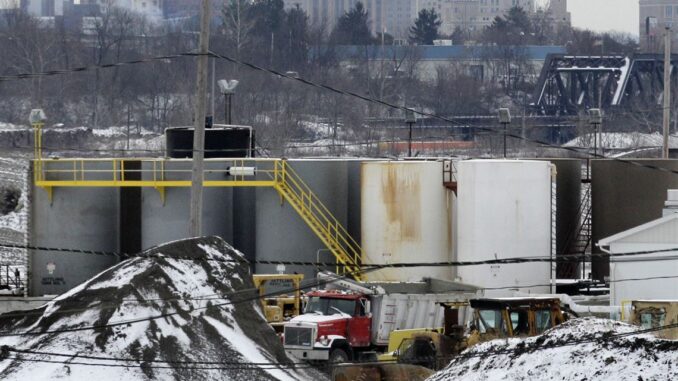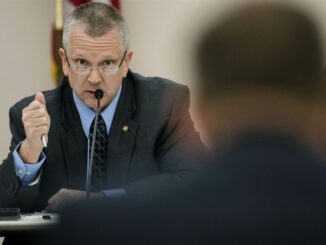
Pennsylvania is taking the first step toward regulating carbon dioxide injection wells, and perhaps all injection wells within its borders, an official with the Department of Environmental Protection said on Monday.
Kurt Klapkowski, acting deputy secretary for oil and gas management, said the agency will give notice to the U.S. Environmental Protection Agency as soon as this week that it plans to apply for primacy.
If the eventual application succeeds, it would put the DEP in charge of permitting and overseeing an industry that doesn’t exist yet but is among the buzziest of the energy transition: Permanent carbon sequestration in rock layers deep below the surface of the earth.
Several companies, including Shell and Archaea Energy Inc., have expressed interest in developing carbon injection wells.
“We hope to decrease significantly the administrative burden on these projects,” Mr. Klapkowski said at Monday’s meeting of the Oil and Gas Technical Advisory Board.
He said the agency is also considering asking for primacy — that is, regulatory authority — over other types of federally regulated injections wells, such as those used in the disposal of oil and gas wastewater, enhanced recovery wells and geothermal wells.
Enhanced oil and gas recovery wells involve injecting a substance, whether it’s brine or carbon dioxide, into a production well to coax more product from the ground. CO2 is already used for enhanced oil recovery elsewhere. And because not all of it comes back to the surface after injection, such wells are sometimes referred to as incidental carbon storage wells.
Over the past few years, as excitement about Pennsylvania’s potential as a carbon storage shelf ran up against the yearslong process of permitting a CO2 storage well, also known as a Class VI well, some in the oil and gas industry suggested that enhanced recovery wells, known as a Class II, might be a quicker path.
There has also been interest in converting depleted oil and gas bores to geothermal wells, Mr. Klapkowski said. These wells use the thermal energy of the earth to help heat or cool buildings.
The Energy transition
Momentum for the transition comes in part from incentives in recent federal legislation, such as the 2021 Infrastructure Investment and Jobs Act and last year’s Inflation Reduction Act. Both allocate billions of dollars for efforts under the umbrella of energy transition, a movement to decarbonize all aspects of the U.S. economy. President Joe Biden has set a goal of 50% fewer carbon emissions by 2030 (compared with 2005) and a net-zero economy by 2050.
In Pennsylvania — which ranks second in the country in natural gas production, third in coal production and fourth in energy-related carbon dioxide emissions — the decarbonization idea capturing industry imagination and government support is a hydrogen and carbon storage hub.
The concept marries the production of hydrogen (itself, a carbon-free fuel) from the state’s vast natural gas resources with the capture and storage of carbon dioxide produced from that process, and from other industrial processes, such as steel and cement manufacturing.
It’s “not a zero-carbon opportunity,” noted Kris Carter, assistant state geologist with the Pennsylvania Geological Survey, who also spoke at the advisory board meeting on Monday. But it is a low-carbon opportunity and, in her opinion, a viable path for the state to lower emissions in the short to medium term. This path is widely opposed by environmental groups who believe it’s being pursued simply to extend the life of fossil fuel companies.
“Pennsylvania has a lot of industry. We cannot decarbonize all aspects of our industry simply by switching fuels,” Ms. Carter said. “Unless you’re going to stop making cement, stop making steel, it’s going take carbon capture and storage.”
Injection well primacy is one of several pillars that advocates of the hydrogen/carbon storage hub believe will be needed to advance the concept.
The others: Characterizing rock formations that would actually host the CO2 by drilling test wells, figuring out who legally owns the pores in those formations and resolving long-term liability for the stored carbon.
With respect to the geology, Ms. Carter said that while a lot is known about the layers of the earth from which companies have extracted various resources over the past 200 years, the formations that would hold CO2 in Pennsylvania —“the deepest part of the Appalachian basin” — have not been well characterized.
“We don’t know what we don’t know about those deepest layers,” she said.
Theoretically, the state can host billions of tons of CO2, Ms. Carter said. But geological and economic details, once they emerge, will taper that theory into a narrower reality.
Pennsylvania isn’t likely to be the big kahuna in carbon storage — not like the Southeastern U.S. or the Illinois basin, where the depth of the basement rock is a mile under the surface. In Pennsylvania, that distance only gets you as far as the Marcellus Shale. Basement rock is few miles below that.
“But we’re going to be a gateway to the offshore storage projects,” she predicted, where geological sandstone layers off the coast are expected to be able to absorb more CO2.
First step
Mr. Klapkowski said on Monday that the process to secure primacy over injection wells will not be “easy” or “straightforward.” A letter of notice to the EPA is just the first pitch in a long game.
For one, Pennsylvania would have to stand up a regulatory structure that wins the EPA’s approval.
“We have not even drafted any rules and we don’t have explicit legislative authority to do that,” Kevin Garber, an attorney and shareholder with Babst Calland. He spoke during a webinar last week organized by Appalachian Energy Future, a group of oil and gas and industrial firms in Pennsylvania, West Virginia and Ohio interested in establishing a hydrogen and carbon storage hub.
“To obtain primacy, it’s quite a complicated process,” he said. “The governor has to weigh in.”
In the tri-state area, Mr. Garber said West Virginia is the closest to finishing that process, by developing rules that mirror the EPA’s standards.
Mr. Klapkowski acknowledged on Monday that “there’s going to have to be regulatory updates for the DEP to walk through the door at EPA and say with a straight face, ‘We think our injection control program is as stringent as the EPA’s.’”
Two states have gone through the process so far. North Dakota, the first, got approval for primacy in six years, he said. For Wyoming, it took three years.



